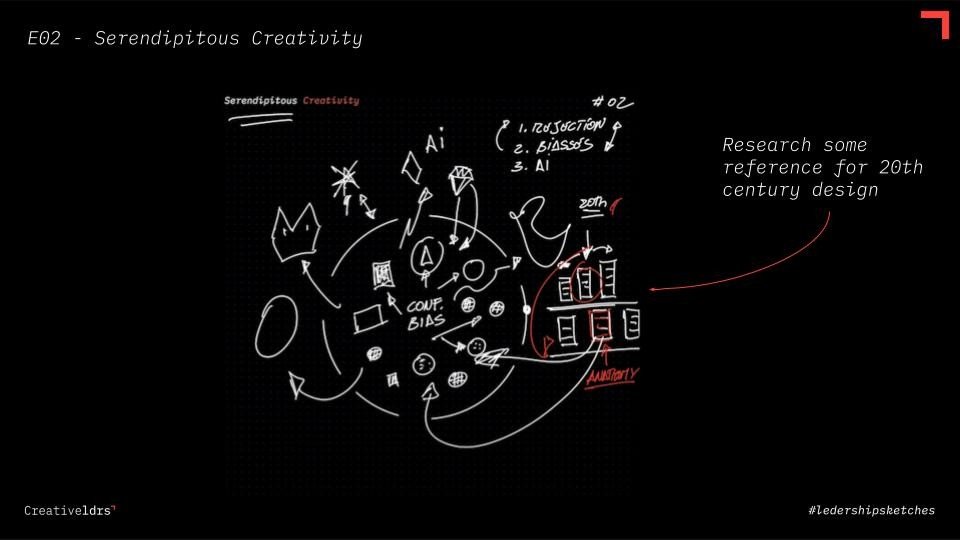#02 - A touch of Serendipitous Creativity
Hello and welcome to Leadership Sketches, our weekly reality check on Creative Leadership. Every week I want to share ideas and best practices about creativity, leadership, and everything in between. In this sketch:
A touch of Serendipitous Creativity
Today we are going to talk about Rejection, Biases, and how AI must be implemented with Serendipity.
But first, we must ask ourselves:
Why do people reject ideas?
We need to understand why people reject new, creative ideas.
There is a powerful bias that we are all subject to, which is called the Confirmation Bias.
Let’s represent our own personal knowledge as a bubble.
Inside, we have what we call our Conventional Knowledge, the knowledge we already possess.
The Confirmation bias tells us that we tend to prefer ideas that are within our field of competence, within our knowledge.
The tricky part is that:
The more knowledgeable we are, the more cultured we are, and the more experience we have, the stronger our confirmation bias is. In turn, we tend to reject anything that is beyond our own knowledge.
We rely on:
“I've done this before; I know how this works; this is not going to work.”
But what's there? What's outside of our conventional knowledge?
Outside of our conventional knowledge, there are all sorts of interesting things. There are all sorts of unexpected, beautiful ideas. There are diamonds out there!
Usually, when we present a new idea to our management, clients, market…etc, if it is outside of their bubble, they are more likely to reject it. Why?
Because understanding a new idea requires us to fill in a knowledge gap, which is perceived as being very costly in terms of mental energy.
But once we realize that we're in the middle of a very limited knowledge bubble, once we acknowledge our duty to explore new possibilities and embrace uncertainty, we're prompted to ask ourselves:
How do I connect with what's outside of my bubble?
And Creativity is at the heart of this transition. When I talk about 'disruption', that's exactly what I mean. It's not just about disrupting the hierarchical structure we find ourselves working in, but primarily, it is about disrupting our own awareness.
Creativity is all about:
willingly breaking the boundaries of our own bubble;
It is about taking action and making an effort to connect dots that were previously outside of our knowledge.
Now this might sound like a challenging process, but luckily we've got some nifty tricks to make our minds embrace this adventure and wonder.
An interesting exercise
An interesting exercise that I used to do with my students. The task was to collect references for their design projects. I would ask them to go into the library and search for a book, a specific book, let's say Graphic design of the 20th century or something like that.
Then I will ask them to pick up either the next book or the book below, even if these were books that had nothing to do with 20th-century design.
Let's say that they could find, for instance, an Anatomy and a botany book, right? They now have discovered serendipitously other references. This process allows what we call Serendipitous Creativity, which means we are able to bring in, within our knowledge, all sorts of interesting ideas that previously we couldn't even see or couldn't even think of.
Serendipity and AI
Now, all kinds of tools are coming out, from OpenAI to Midjourney.
They are wonderful tools, but I feel there might be an issue. Sometimes we need to implement them with Serendipitous Creativity. Otherwise, they will not bring us too far.
Especially with Generative AI, we need to craft a very specific prompt. But when we craft a specific prompt, we usually rely on things that we know.
Unless you tell the machine that you are going to look for 20th-century design and link that with anatomy or botany, this kind of random research is not going to happen.
The machine is not gonna give us a random thought or a serendipitous thought. And I feel there is a wealth of information that can be gained just by taking a stroll (or picking up the “wrong” book. 😉) and trying to connect those dots that previously were far apart.
So this is an important part of our creativity, which is trying to find all those interesting things that are beyond our conventional knowledge and try to take these things and bring them into our view, and try to fight this bias which says:
“I'm right because the things I already know tell me I am.”
But what about you? What do you think?
How would you foster Serendipitous Creativity?
Let me know what you think in the comments or in our community. What would you do to challenge yourself and try to go beyond what you already know?
As usual, this is leadership sketches. I'm Gianluca Cinquepalmi and don't forget, until next sketch: Inspire, Challenge, and Disrupt.



